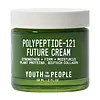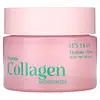What's inside
What's inside
 Key Ingredients
Key Ingredients

 Benefits
Benefits

 Concerns
Concerns

 Ingredients Side-by-side
Ingredients Side-by-side

Water
Skin ConditioningDicaprylyl Carbonate
EmollientHydrolyzed Hyaluronic Acid
HumectantTrimethylolpropane Tricaprylate/Tricaprate
EmollientTridecyl Trimellitate
EmollientPropanediol
SolventSh-Polypeptide-121
Skin ConditioningPolyglyceryl-3 Methylglucose Distearate
EmulsifyingPanthenol
Skin ConditioningNiacinamide
SmoothingProline
Skin ConditioningTocopheryl Acetate
AntioxidantAloe Barbadensis Leaf Juice
Skin ConditioningHydrolyzed Cannabis Sativa Seed Extract
Skin ConditioningHydrolyzed Rice Protein
Skin ConditioningHydrolyzed Pea Protein
EmollientSalvia Hispanica Seed Extract
EmollientAcetyl Tetrapeptide-11
Skin ConditioningAcetyl Tetrapeptide-9
Skin ConditioningAcetyl Tetrapeptide-2
Skin ConditioningHibiscus Esculentus Fruit Extract
Skin ConditioningAmmonium Acryloyldimethyltaurate/Beheneth-25 Methacrylate Crosspolymer
Emulsion StabilisingHydrolyzed Linseed Seed
HumectantCastor Oil/Ipdi Copolymer
Ceramide AP
Skin ConditioningCeramide NP
Skin ConditioningCetearyl Alcohol
EmollientCetearyl Glucoside
EmulsifyingGlycerin
HumectantHydrolyzed Sodium Hyaluronate
Skin ConditioningCoco-Caprylate/Caprate
EmollientDilinoleic Acid
EmollientBenzyl Alcohol
PerfumingZingiber Officinale Root Extract
MaskingBisabolol
MaskingCaprylyl Glycol
EmollientCarbomer
Emulsion StabilisingDimethyl Isosorbide
SolventDipropylene Glycol
HumectantErythritol
HumectantEthylhexylglycerin
Skin ConditioningGlucose
Humectant1,2-Hexanediol
Skin ConditioningTrisodium Ethylenediamine Disuccinate
Glyceryl Stearate
EmollientPhytosphingosine
Skin ConditioningPolyacrylate Crosspolymer-6
Emulsion StabilisingPolysorbate 20
EmulsifyingCaprylhydroxamic Acid
Potassium Sorbate
PreservativeGlycine
BufferingHydroxyacetophenone
AntioxidantSodium Benzoate
MaskingT-Butyl Alcohol
PerfumingCitric Acid
BufferingSodium Citrate
BufferingSodium Lactate
BufferingTriheptanoin
Skin ConditioningXanthan Gum
EmulsifyingWater, Dicaprylyl Carbonate, Hydrolyzed Hyaluronic Acid, Trimethylolpropane Tricaprylate/Tricaprate, Tridecyl Trimellitate, Propanediol, Sh-Polypeptide-121, Polyglyceryl-3 Methylglucose Distearate, Panthenol, Niacinamide, Proline, Tocopheryl Acetate, Aloe Barbadensis Leaf Juice, Hydrolyzed Cannabis Sativa Seed Extract, Hydrolyzed Rice Protein, Hydrolyzed Pea Protein, Salvia Hispanica Seed Extract, Acetyl Tetrapeptide-11, Acetyl Tetrapeptide-9, Acetyl Tetrapeptide-2, Hibiscus Esculentus Fruit Extract, Ammonium Acryloyldimethyltaurate/Beheneth-25 Methacrylate Crosspolymer, Hydrolyzed Linseed Seed, Castor Oil/Ipdi Copolymer, Ceramide AP, Ceramide NP, Cetearyl Alcohol, Cetearyl Glucoside, Glycerin, Hydrolyzed Sodium Hyaluronate, Coco-Caprylate/Caprate, Dilinoleic Acid, Benzyl Alcohol, Zingiber Officinale Root Extract, Bisabolol, Caprylyl Glycol, Carbomer, Dimethyl Isosorbide, Dipropylene Glycol, Erythritol, Ethylhexylglycerin, Glucose, 1,2-Hexanediol, Trisodium Ethylenediamine Disuccinate, Glyceryl Stearate, Phytosphingosine, Polyacrylate Crosspolymer-6, Polysorbate 20, Caprylhydroxamic Acid, Potassium Sorbate, Glycine, Hydroxyacetophenone, Sodium Benzoate, T-Butyl Alcohol, Citric Acid, Sodium Citrate, Sodium Lactate, Triheptanoin, Xanthan Gum
Water
Skin ConditioningOctyldodecanol
EmollientHydrogenated Polyisobutene
EmollientButylene Glycol
HumectantGlycereth-26
HumectantGlycerin
HumectantPEG-20 Methyl Glucose Sesquistearate
EmulsifyingStearyl Alcohol
EmollientCetearyl Alcohol
EmollientSodium Polyacrylate
AbsorbentDipropylene Glycol
Humectant1,2-Hexanediol
Skin ConditioningEthylhexyl Hydroxystearate
EmollientHydroxyacetophenone
AntioxidantMethyl Glucose Sesquistearate
EmollientCollagen Extract
Skin ConditioningTocopheryl Acetate
AntioxidantCaprylyl Glycol
EmollientTrideceth-6
EmulsifyingAdenosine
Skin ConditioningSodium Hyaluronate
HumectantJuniperus Mexicana Oil
MaskingDisodium EDTA
Pyrus Communis Fruit Extract
Skin ConditioningRosa Damascena Flower Water
MaskingMelia Azadirachta Flower Extract
Skin ConditioningMelia Azadirachta Leaf Extract
Skin ConditioningIris Florentina Root Extract
MaskingRosa Damascena Flower Oil
MaskingCucumis Melo Fruit Extract
Skin ConditioningHedera Helix Leaf/Stem Extract
AntimicrobialBetaine
HumectantDipotassium Glycyrrhizate
HumectantCoccinia Indica Fruit Extract
Skin ConditioningPogostemon Cablin Leaf Oil
MaskingAvena Sativa Peptide
Skin ConditioningCorallina Officinalis Extract
Skin ConditioningVetiveria Zizanoides Root Oil
MaskingWater, Octyldodecanol, Hydrogenated Polyisobutene, Butylene Glycol, Glycereth-26, Glycerin, PEG-20 Methyl Glucose Sesquistearate, Stearyl Alcohol, Cetearyl Alcohol, Sodium Polyacrylate, Dipropylene Glycol, 1,2-Hexanediol, Ethylhexyl Hydroxystearate, Hydroxyacetophenone, Methyl Glucose Sesquistearate, Collagen Extract, Tocopheryl Acetate, Caprylyl Glycol, Trideceth-6, Adenosine, Sodium Hyaluronate, Juniperus Mexicana Oil, Disodium EDTA, Pyrus Communis Fruit Extract, Rosa Damascena Flower Water, Melia Azadirachta Flower Extract, Melia Azadirachta Leaf Extract, Iris Florentina Root Extract, Rosa Damascena Flower Oil, Cucumis Melo Fruit Extract, Hedera Helix Leaf/Stem Extract, Betaine, Dipotassium Glycyrrhizate, Coccinia Indica Fruit Extract, Pogostemon Cablin Leaf Oil, Avena Sativa Peptide, Corallina Officinalis Extract, Vetiveria Zizanoides Root Oil
 Reviews
Reviews

Ingredients Explained
These ingredients are found in both products.
Ingredients higher up in an ingredient list are typically present in a larger amount.
1,2-Hexanediol is a synthetic liquid and another multi-functional powerhouse.
It is a:
- Humectant, drawing moisture into the skin
- Emollient, helping to soften skin
- Solvent, dispersing and stabilizing formulas
- Preservative booster, enhancing the antimicrobial activity of other preservatives
Caprylyl Glycol is a humectant and emollient, meaning it attracts and preserves moisture.
It is a common ingredient in many products, especially those designed to hydrate skin. The primary benefits are retaining moisture, skin softening, and promoting a healthy skin barrier.
Though Caprylyl Glycol is an alcohol derived from fatty acids, it is not the kind that can dry out skin.
This ingredient is also used as a preservative to extend the life of products. It has slight antimicrobial properties.
Learn more about Caprylyl GlycolCetearyl alcohol is a mixture of two fatty alcohols: cetyl alcohol and stearyl alcohol. It is mainly used as an emulsifier. Emulsifiers help prevent the separation of oils and products. Due to its composition, it can also be used to thicken a product or help create foam.
Cetearyl alcohol is an emollient. Emollients help soothe and hydrate the skin by trapping moisture.
Studies show Cetearyl alcohol is non-toxic and non-irritating. The FDA allows products labeled "alcohol-free" to have fatty alcohols.
This ingredient is usually derived from plant oils such as palm, vegetable, or coconut oils. There is debate on whether this ingredient will cause acne.
Due to the fatty acid base, this ingredient may not be Malassezia folliculitis safe.
Learn more about Cetearyl AlcoholDipropylene Glycol is a synthetically created humectant, stabilizer, and solvent.
This ingredient helps:
Dipropylene glycol is technically an alcohol, but it belongs to the glycol family (often considered part of the ‘good’ alcohols). This means it is hydrating and gentle on skin unlike drying solvent alcohols like denatured alcohol.
As a masking agent, Dipropylene Glycol can be used to cover the smell of other ingredients. However, it does not have a scent.
Studies show Dipropylene Glycol is considered safe to use in skincare.
Learn more about Dipropylene GlycolGlycerin is already naturally found in your skin. It helps moisturize and protect your skin.
A study from 2016 found glycerin to be more effective as a humectant than AHAs and hyaluronic acid.
As a humectant, it helps the skin stay hydrated by pulling moisture to your skin. The low molecular weight of glycerin allows it to pull moisture into the deeper layers of your skin.
Hydrated skin improves your skin barrier; Your skin barrier helps protect against irritants and bacteria.
Glycerin has also been found to have antimicrobial and antiviral properties. Due to these properties, glycerin is often used in wound and burn treatments.
In cosmetics, glycerin is usually derived from plants such as soybean or palm. However, it can also be sourced from animals, such as tallow or animal fat.
This ingredient is organic, colorless, odorless, and non-toxic.
Glycerin is the name for this ingredient in American English. British English uses Glycerol/Glycerine.
Learn more about GlycerinHydroxyacetophenone is antioxidant with skin conditioning and soothing properties. It also boosts the efficiency of preservatives.
This ingredient is not irritating or sensitizing.
Tocopheryl Acetate is AKA Vitamin E. It is an antioxidant and protects your skin from free radicals. Free radicals damage the skin by breaking down collagen.
One study found using Tocopheryl Acetate with Vitamin C decreased the number of sunburned cells.
Tocopheryl Acetate is commonly found in both skincare and dietary supplements.
Learn more about Tocopheryl AcetateWater. It's the most common cosmetic ingredient of all. You'll usually see it at the top of ingredient lists, meaning that it makes up the largest part of the product.
So why is it so popular? Water most often acts as a solvent - this means that it helps dissolve other ingredients into the formulation.
You'll also recognize water as that liquid we all need to stay alive. If you see this, drink a glass of water. Stay hydrated!
Learn more about Water